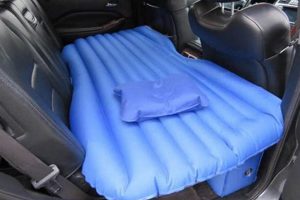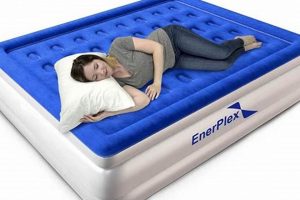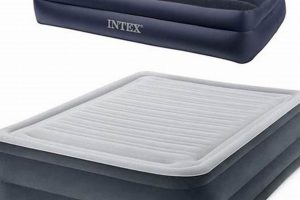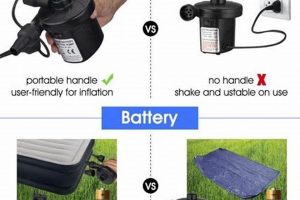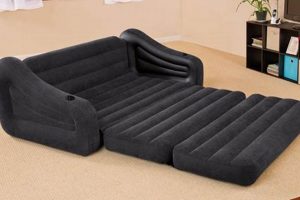The process of repairing a breach in the airtight seal of an inflatable sleeping surface, typically constructed from polyvinyl chloride (PVC) or similar material, is essential for maintaining its functionality. Successful execution of this procedure involves locating the perforation, preparing the surrounding surface, and applying an adhesive patch designed to create an airtight bond. For instance, a slow leak might render the mattress unusable during sleep, necessitating immediate repair to restore its intended purpose.
Addressing damage to inflatable sleeping surfaces is significant due to its implications for comfort, convenience, and cost-effectiveness. A properly repaired mattress can extend its lifespan, preventing premature disposal and the associated expense of replacement. Historically, various methods have been employed, ranging from rudimentary adhesives to specialized repair kits, reflecting a continuous effort to improve the durability and usability of inflatable sleeping solutions. This extends the utility of the product, preventing potential waste and saving resources.
Effective remediation requires a methodical approach. The subsequent sections will detail the necessary materials, techniques for pinpointing leaks, optimal surface preparation strategies, and recommended procedures for patch application and curing to ensure a durable and reliable seal. This will empower individuals to undertake repairs with confidence and achieve lasting results.
Repairing Inflatable Sleeping Surfaces
Effective repair of inflatable sleeping surfaces requires careful attention to detail. The following guidelines offer strategies to ensure a lasting and airtight seal.
Tip 1: Clean the Repair Area. Contaminants such as dirt, oils, or moisture impede adhesion. Isopropyl alcohol is recommended for thorough cleaning. A clean surface promotes a strong and lasting bond between the mattress material and the patch.
Tip 2: Select an Appropriately Sized Patch. The patch should extend at least one inch beyond the perimeter of the damage in all directions. This ensures sufficient surface area for adhesion and prevents stress concentration at the edges of the patch.
Tip 3: Apply Adhesive Sparingly. Excessive adhesive can compromise the bond. A thin, even coat applied to both the mattress surface and the patch is generally sufficient. Allow the adhesive to become tacky before bonding.
Tip 4: Use a Roller or Hard, Smooth Object to Apply Pressure. Applying uniform pressure across the patch’s surface ensures proper adhesion. Avoid air pockets that could weaken the bond.
Tip 5: Allow Sufficient Curing Time. Adhesives require time to fully cure. Consult the manufacturer’s instructions for the recommended curing period. Avoid inflating the mattress prematurely.
Tip 6: Test the Repair Before Full Inflation. Partially inflate the mattress to check for leaks around the patch. If leaks are detected, reinforce the repair as needed.
Tip 7: Consider a Flexible Patch Material. Materials such as vinyl or rubber patches offer better flexibility and conformity to the mattress surface compared to rigid options. This reduces the likelihood of the patch peeling or cracking over time.
Adhering to these recommendations maximizes the likelihood of a successful and long-lasting repair, extending the lifespan of the inflatable sleeping surface.
These tips provide a foundation for effective maintenance, leading to increased product longevity.
1. Leak Location
The accurate determination of the site of egress in an inflatable sleeping surface constitutes the foundational step in its effective remediation. The correlation between precise identification of the perforation and successful repair is axiomatic; without pinpointing the exact source of leakage, any patching attempt is rendered speculative and unlikely to provide a durable seal. The process involves meticulous inspection of the mattress surface, often employing a solution of soapy water to visualize air escaping from the breach. For instance, a small puncture caused by a sharp object might not be immediately visible, but the formation of bubbles upon application of the soapy solution provides definitive confirmation of its location.
Failure to properly locate the leak can lead to repeated attempts at patching the wrong area, resulting in wasted materials, time, and effort. Moreover, the continued loss of air can damage the internal structure of the mattress, potentially exacerbating the initial problem. Consider a scenario where a slow leak is suspected but not definitively located. Applying a patch randomly to a suspected area may temporarily mitigate the air loss, but the actual puncture remains unaddressed, leading to eventual deflation and necessitating further repair attempts. This underscores the importance of a systematic approach to leak detection, employing techniques such as auditory inspection, visual examination, and soapy water testing to ensure accurate identification.
In summary, identifying the specific point of air escaping from an inflatable sleeping surface is a critical factor influencing the outcome of its repair. Precise leak location ensures the applied patch effectively seals the breach, preventing further air loss and extending the lifespan of the mattress. The implications of inaccurate leak detection range from repeated repair attempts to potential damage of the product. Effective execution of the repair process mandates prioritizing accurate localization of the source of the leak as the initial and most critical step.
2. Surface Preparation
Surface preparation directly influences the efficacy of any repair undertaken on an inflatable sleeping surface. It establishes the foundation for adequate adhesion between the patch and the mattress material. Contaminants such as dirt, oils, or residual manufacturing agents inhibit the formation of a strong bond. This, in turn, compromises the airtight seal, rendering the repair ineffective. For instance, if a puncture is patched without prior cleaning, the adhesive may adhere primarily to the surface contaminants rather than the mattress material itself, resulting in premature failure of the repair. Consequently, surface preparation is an indispensable component of a successful patching procedure.
The steps involved in proper surface preparation include cleaning and abrading the area surrounding the damage. Cleaning typically involves the application of a solvent, such as isopropyl alcohol, to remove surface contaminants. Abrading, accomplished using fine-grit sandpaper, creates a slightly roughened surface, increasing the surface area available for adhesion and promoting a stronger mechanical bond between the patch and the mattress. To illustrate, consider a scenario where a small hole is present on a PVC air mattress. After locating the damage, the area surr
ounding the hole is first cleaned with alcohol to remove any dirt. Next, the area is lightly sanded to create a slightly textured surface. This two-step process ensures optimal adhesion of the patch.
In summation, the quality of surface preparation significantly dictates the longevity and reliability of an inflatable sleeping surface repair. Neglecting this step can lead to premature patch failure, necessitating repeated repairs. Therefore, meticulous cleaning and abrasion of the area surrounding the damage are paramount to achieving a durable and airtight seal, extending the lifespan of the product. The process is an investment in the integrity of the repair.
3. Patch Selection
The selection of an appropriate patch material is intrinsically linked to the success of any attempt to repair an inflatable sleeping surface. Patch material must exhibit compatibility with the original mattress composition, typically polyvinyl chloride (PVC) or a similar polymer. Incompatibility can manifest as poor adhesion, leading to premature patch detachment and recurring deflation. Moreover, the patch’s physical properties, including its thickness and flexibility, must align with the anticipated stresses and strains imposed during use. For instance, a rigid patch applied to a high-flexure area of the mattress is prone to cracking or separation. This connection underscores the critical role of informed material selection in the overall repair effectiveness.
Practical application of patch selection principles involves considering factors such as adhesive compatibility, environmental conditions, and the nature of the damage. Adhesives formulated for PVC are generally required for PVC mattresses, while specialized adhesives may be necessary for other materials. Environmental conditions, such as temperature and humidity, can influence adhesive curing and bond strength. The nature of the damagepuncture versus teardictates the size and shape of the patch needed for effective coverage. Consider a scenario where a large tear necessitates a patch with reinforced edges to prevent propagation of the tear beyond the repaired area. Therefore, a detailed assessment of these factors is essential for optimal patch selection.
In summary, patch selection constitutes a critical element in the process of repairing inflatable sleeping surfaces. The choice of patch material directly influences the durability and longevity of the repair. Considerations such as material compatibility, physical properties, and environmental conditions must be carefully evaluated to ensure a secure and lasting seal. A failure to address these factors adequately can result in ineffective repairs and continued deflation, undermining the intended purpose of the repair attempt.
4. Adhesive Application
Adhesive application is a critical determinant in the success of patching an inflatable sleeping surface. The adhesive acts as the bonding agent between the patch and the mattress material; its proper application ensures an airtight seal. Insufficient adhesive compromises the bond, leading to air leakage and premature failure of the repair. Conversely, excessive adhesive can create a weak bond due to improper curing or the formation of air pockets. The technique of adhesive application, therefore, directly impacts the functional integrity of the repaired area. For example, applying too little adhesive around the edges of the patch will inevitably result in peeling and subsequent air loss. Properly executed adhesive application is an indispensable component of a successful repair.
Achieving optimal adhesive application necessitates several considerations. The adhesive type must be compatible with both the mattress and patch materials. Typically, a PVC-specific adhesive is recommended for PVC mattresses. A thin, even coat of adhesive should be applied to both the patch and the prepared surface of the mattress. Allowing the adhesive to become slightly tacky before joining the surfaces maximizes bond strength. Applying pressure during the curing process further promotes adhesion by eliminating air pockets and ensuring uniform contact. Consider a situation where a patch is applied immediately after applying a thick layer of adhesive. The trapped solvent within the adhesive may prevent proper curing, leading to a weak and unreliable bond. Taking the time to properly prepare the surfaces and apply the adhesive correctly ensures the long term success of the patching and ensures air will not leak from the mattress during use.
In conclusion, adhesive application is an essential step in patching an inflatable sleeping surface. The quality of the adhesive bond directly affects the durability and airtightness of the repair. Applying the appropriate type and amount of adhesive, allowing for proper tackiness, and applying pressure during curing are crucial for a lasting seal. Neglecting these factors will undermine the effectiveness of the repair, leading to continued deflation and ultimately negating the efforts to extend the mattress’s lifespan.
5. Pressure Application
Pressure application, a subsequent step in the repair of an inflatable sleeping surface, directly influences the adhesion of the applied patch. Consistent and uniform pressure applied to the patch-mattress interface facilitates optimal contact between the adhesive and the respective surfaces. Inadequate pressure may result in incomplete bonding, rendering the repair susceptible to air leakage. This correlation underscores the instrumental role of pressure application in ensuring the durability and effectiveness of the repair. For instance, the uneven pressure applied manually might create air pockets, which can diminish bond strength and lead to eventual patch failure. This exemplifies the necessity of controlled and sustained pressure during the curing phase.
The practical implementation of this principle involves the use of a roller or a smooth, hard object to uniformly distribute pressure across the entire surface of the patch. The duration of pressure application is contingent upon the adhesive’s specifications, typically outlined in the manufacturer’s guidelines. Insufficient pressure duration can lead to a compromised bond, while excessive pressure, though less common, may distort the patch or the surrounding mattress material. Consider a scenario where a patch is applied to a small puncture on a vinyl air mattress. After adhesive application, a rolling pin is used to exert consistent pressure across the patch for the recommended duration, ensuring a complete and uniform bond. This technique significantly improves the repair’s resistance to stress and prolongs its lifespan.
In summary, pressure application represents a critical phase in the process of patching an inflatable sleeping surface. It ensures the optimal bonding between the patch and the mattress, leading to an airtight and durable repair. Variations in applied pressure or insufficient duration compromise the integrity of the seal, potentially negating the entire repair attempt. Therefore, adhering to proper pressure application techniques is paramount to realizing a successful and long-lasting solution.
6. Curing Time
Curing time constitutes a critical phase in the procedure of patching an inflatable sleeping surface. It represents the period during which the adhesive undergoes chemical changes, solidifying and establishing a robust bond between the patch and the mattress material. Inadequate curing time compromises the adhesive’s ability to reach its full bonding strength, resulting in a weak or incomplete seal. This, in turn, predisposes the repair to air leakage and premature failure. The correlation between sufficient curing time and the ultimate success of the patching process is therefore direct and consequential. For example, if an adhesive requires 24 hours to fully cure, prematurely inflating the mattress after only a few hours can disrupt the bonding process, leading to a compromised repair and air loss.
The duration of the required curing time is contingent upon the specific adhesive used, environmental conditions such as temperature and humidity, and the materials of both the patch and the mattress. Manufacturers typically provide specific curing time recommendations on the adhesive product label. Deviating from these guidelines can significantly affect the repair’s longevity. Consider a scenario where a rapid-cure adhesive is employed under high humidity conditions. The elevated moisture levels may extend the necessary curing time, requiring an adjustment to the manufacturer’s recommended period. Monitoring the curing process and ensuring adherence to recommended timeframes maximizes the likelihood of a durable and airtight seal, directly impacting the long-term performance of the repaired air mattress.
In summary, curing time is a non-negotiable element in the effective repair of inflatable sleeping surfaces. Adherence to specified curing durations ensures the adhesive achieves its full bonding potential, creating a durable and airtight seal. Failure to provide adequate curing time can undermine the entire repair effort, leading to recurring air loss and reduced mattress lifespan. Prioritizing this stage, with due consideration to environmental factors and manufacturer guidelines, significantly enhances the likelihood of a successful and enduring repair.
7. Testing Integrity
The assessment of repair integrity represents a critical stage in the process of addressing breaches in inflatable sleeping surfaces, functioning as the validation step within the broader procedure. The efficacy of any patching endeavor is fundamentally dependent upon confirming that the repair effectively restores the airtight nature of the mattress. Without rigorously testing the integrity of the repaired area, the presence of residual leaks remains uncertain, potentially leading to renewed deflation and rendering the repair incomplete. Therefore, testing integrity constitutes an indispensable component in verifying the success of how to patch a hole in air mattress.
Practical testing typically involves a multifaceted approach. Initially, visual inspection is conducted to examine the patch’s adhesion to the mattress surface, identifying any signs of lifting or separation. Subsequently, auditory assessment, listening for subtle hissing sounds indicative of air escaping, may reveal localized leaks. A more definitive method involves the application of a soapy water solution to the repaired area. The formation of bubbles confirms the presence of an air leak, necessitating further repair attempts. Consider a scenario where a seemingly successful patch is applied to a puncture, but subsequent soapy water testing reveals small bubbles emanating from the patch’s perimeter. This discovery necessitates reinforcing the patch edges with additional adhesive to ensure a complete seal. Without these testing procedures, a faulty seal is likely.
In conclusion, testing integrity is not merely a procedural formality but an essential verification step that directly determines the effectiveness of how to patch a hole in air mattress. Employing visual, auditory, and soapy water assessments confirms the repair’s airtightness, preventing future air loss and ensuring the prolonged usability of the mattress. Failure to conduct thorough integrity testing renders the entire repair process incomplete, risking continued deflation and undermining the effort invested in the patching process. Therefore, testing is a crucial step.
Frequently Asked Questions
The following section addresses common inquiries regarding the effective repair of inflatable sleeping surfaces. The information aims to provide clarity and guidance for individuals undertaking these repairs.
Question 1: What materials are typically required to patch an air mattress?
The process generally necessitates a patch (typically PVC or a similar polymer), adhesive designed for flexible plastics, a cleaning agent such as isopropyl alcohol, fine-grit sandpaper, and a tool for applying even pressure, such as a roller.
Question 2: How is the precise location of a leak determined in an air mattress?
The application of a soapy water solution to the inflated mattress is often used. The formation of bubbles indicates the presence and location of a leak.
Question 3: Is surface preparation truly necessary before applying a patch?
Yes. Surface preparation, involving cleaning and abrasion, removes contaminants and creates a textured surface, promoting optimal adhesion between the patch and the mattress material. This is a crucial step.
Question 4: How long should the adhesive be allowed to cure after patching an air mattress?
The curing time is contingent upon the adhesive type. Manufacturers’ instructions should be consulted, as premature inflation can compromise the bond. Typically, 24-48 hours is required.
Question 5: How can the integrity of the repair be tested following the patching procedure?
Re-application of a soapy water solution to the patched area is recommended. The absence of bubbles indicates a successful, airtight seal.
Question 6: Are all adhesives suitable for patching an air mattress?
No. Only adhesives specifically formulated for flexible plastics, such as PVC, should be employed. General-purpose adhesives may lack the necessary bonding characteristics to withstand the stresses associated with inflatable surfaces.
These FAQs provide a foundational understanding of the key considerations in repairing inflatable sleeping surfaces, promoting successful and durable repairs.
This concludes the Frequently Asked Questions section. Further topics will elaborate on advanced repair techniques and preventative maintenance strategies.
Conclusion
This article has systematically explored the essential aspects of how to patch a hole in air mattress, emphasizing the criticality of each step. From leak detection and surface preparation to appropriate patch selection, adhesive application, and thorough testing, the process demands precision and adherence to established techniques. Neglecting any stage compromises the integrity of the repair, potentially leading to recurring deflation and diminished product lifespan.
Mastering these techniques empowers individuals to extend the service life of inflatable sleeping surfaces, reducing waste and minimizing the need for replacements. Effective repair constitutes a responsible and cost-effective approach to maintaining the functionality of these products. The long-term benefit of correctly patching an inflatable surface is the reduced use of res
ources in manufacturing replacements.


